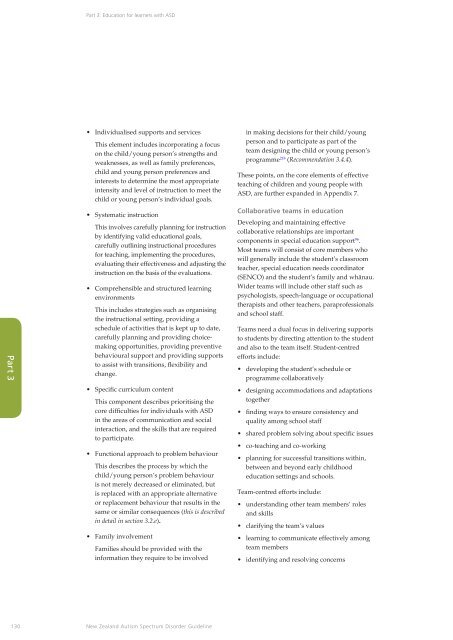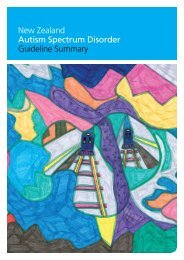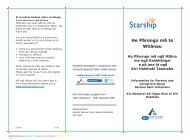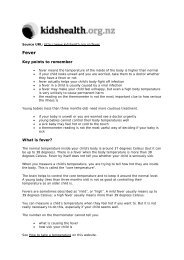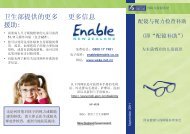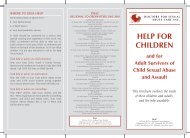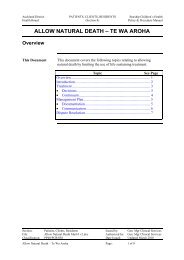New Zealand Autism Spectrum Disorder Guideline - Ministry of Health
New Zealand Autism Spectrum Disorder Guideline - Ministry of Health
New Zealand Autism Spectrum Disorder Guideline - Ministry of Health
You also want an ePaper? Increase the reach of your titles
YUMPU automatically turns print PDFs into web optimized ePapers that Google loves.
Part 3: Education for learners with ASD<br />
Part 3<br />
• Individualised supports and services<br />
This element includes incorporating a focus<br />
on the child/young person’s strengths and<br />
weaknesses, as well as family preferences,<br />
child and young person preferences and<br />
interests to determine the most appropriate<br />
intensity and level <strong>of</strong> instruction to meet the<br />
child or young person’s individual goals.<br />
• Systematic instruction<br />
This involves carefully planning for instruction<br />
by identifying valid educational goals,<br />
carefully outlining instructional procedures<br />
for teaching, implementing the procedures,<br />
evaluating their effectiveness and adjusting the<br />
instruction on the basis <strong>of</strong> the evaluations.<br />
• Comprehensible and structured learning<br />
environments<br />
This includes strategies such as organising<br />
the instructional setting, providing a<br />
schedule <strong>of</strong> activities that is kept up to date,<br />
carefully planning and providing choicemaking<br />
opportunities, providing preventive<br />
behavioural support and providing supports<br />
to assist with transitions, flexibility and<br />
change.<br />
• Specific curriculum content<br />
This component describes prioritising the<br />
core difficulties for individuals with ASD<br />
in the areas <strong>of</strong> communication and social<br />
interaction, and the skills that are required<br />
to participate.<br />
• Functional approach to problem behaviour<br />
This describes the process by which the<br />
child/young person’s problem behaviour<br />
is not merely decreased or eliminated, but<br />
is replaced with an appropriate alternative<br />
or replacement behaviour that results in the<br />
same or similar consequences (this is described<br />
in detail in section 3.2.e).<br />
• Family involvement<br />
Families should be provided with the<br />
information they require to be involved<br />
in making decisions for their child/young<br />
person and to participate as part <strong>of</strong> the<br />
team designing the child or young person’s<br />
programme 218 (Recommendation 3.4.4).<br />
These points, on the core elements <strong>of</strong> effective<br />
teaching <strong>of</strong> children and young people with<br />
ASD, are further expanded in Appendix 7.<br />
Collaborative teams in education<br />
Developing and maintaining effective<br />
collaborative relationships are important<br />
components in special education support 96 .<br />
Most teams will consist <strong>of</strong> core members who<br />
will generally include the student’s classroom<br />
teacher, special education needs coordinator<br />
(SENCO) and the student’s family and whänau.<br />
Wider teams will include other staff such as<br />
psychologists, speech-language or occupational<br />
therapists and other teachers, parapr<strong>of</strong>essionals<br />
and school staff.<br />
Teams need a dual focus in delivering supports<br />
to students by directing attention to the student<br />
and also to the team itself. Student-centred<br />
efforts include:<br />
• developing the student’s schedule or<br />
programme collaboratively<br />
• designing accommodations and adaptations<br />
together<br />
• finding ways to ensure consistency and<br />
quality among school staff<br />
• shared problem solving about specific issues<br />
• co-teaching and co-working<br />
• planning for successful transitions within,<br />
between and beyond early childhood<br />
education settings and schools.<br />
Team-centred efforts include:<br />
• understanding other team members’ roles<br />
and skills<br />
• clarifying the team’s values<br />
• learning to communicate effectively among<br />
team members<br />
• identifying and resolving concerns<br />
130<br />
<strong>New</strong> <strong>Zealand</strong> <strong>Autism</strong> <strong>Spectrum</strong> <strong>Disorder</strong> <strong>Guideline</strong>


